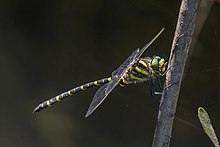Golden-ringed dragonfly
| Golden-ringed dragonfly | |
|---|---|

| |
| male Fermyn Woods, Northamptonshire | |
| Scientific classification | |
| Kingdom: | |
| Phylum: | |
| Class: | |
| Order: | |
| Suborder: | |
| Family: | |
| Genus: | |
| Species: | C. boltonii
|
| Binomial name | |
| Cordulegaster boltonii (Donovan, 1807)
| |
The golden-ringed dragonfly (Cordulegaster boltonii) is a large, striking dragonfly and the longest British species,[1] the only member of its genus to be found in the United Kingdom.[2]
Identification
They are easily identified by their distinctive black and yellow stripes, which no other dragonfly in the United Kingdom has.[3] A very large species, males average 74 mm and the larger females 84 mm. Wingspan is up to 101 mm.[4]
Larvae
The female lays the eggs in shallow water. The hairy larvae live at the bottom of the water and are well camouflaged amongst the silt.[5] They emerge after about 2–5 years, and usually under the cover of darkness.
Behaviour
They are often seen flying leisurely over mountain streams or a river; they also occasionally show up at a pond. They are also typically seen flying over heath land. Their bright yellow and black stripes make them easy to identify, even from a fair distance away. They feed mainly on insects ranging from small prey such as midges to flies, butterflies and even bumblebees. This strikingly-coloured insect is incredibly aerobatic and they sometimes fly very high up into the sky.[6]
See also

External links
 Media related to Cordulegaster boltonii at Wikimedia Commons
Media related to Cordulegaster boltonii at Wikimedia Commons Data related to Cordulegaster boltonii at Wikispecies
Data related to Cordulegaster boltonii at Wikispecies
References
- ^ "Cordulegaster boltonii". British Dragonfly Society. Retrieved 18 August 2010.
- ^ "Golden-ringed dragonfly (Cordulegaster boltonii)". ARKive. Retrieved February 7, 2008.
- ^ "UK Safari". Retrieved 2008-02-07.
- ^ http://www.arkive.org/golden-ringed-dragonfly/cordulegaster-boltonii/
- ^ "Wild Scotland". Archived from the original on October 6, 2008. Retrieved 2008-02-07.
{{cite web}}: Unknown parameter|deadurl=ignored (|url-status=suggested) (help) - ^ "Dragonflies at Plas Farm". Retrieved 2008-02-07.
